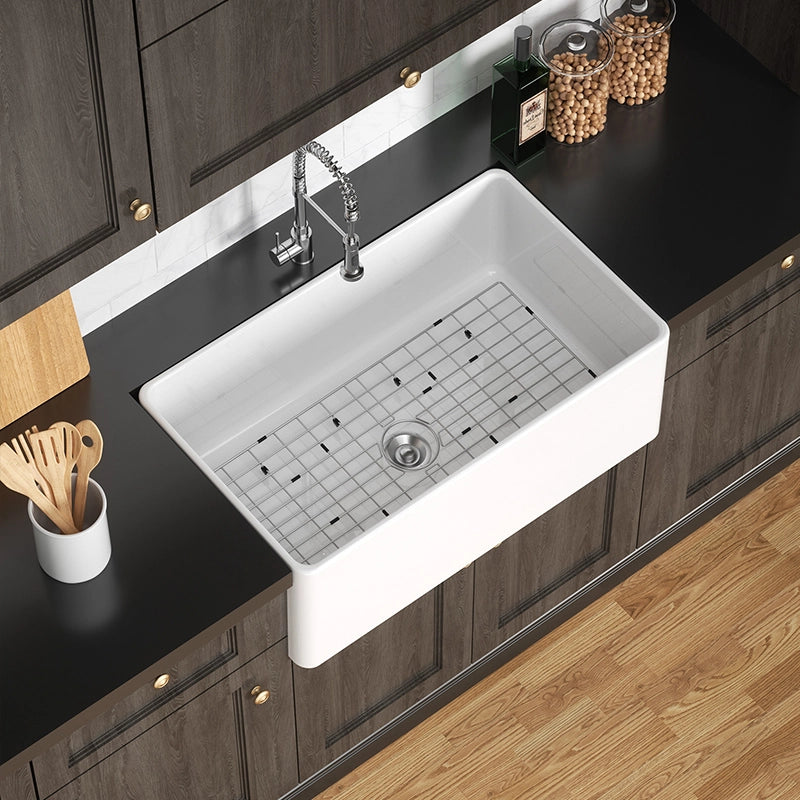The installation of a farmhouse sink in your kitchen brings you excitement. This detailed guide will walk you through the differences between farmhouse sinks and traditional sinks. You will learn about the many benefits and how to measure precisely for a perfect fit. We will also cover the entire installation process. Let’s start your DIY farmhouse sink installation journey!
What Is a Farmhouse Sink?
A farmhouse sink—also known as an apron-front sink—is a distinctive type of kitchen sink characterized by its large, deep basin and exposed, forward-facing front panel, known as the “apron.” Unlike traditional sinks that are set back into the countertop and cabinetry, a farmhouse sink extends slightly beyond the edge of the counter, creating a bold, eye-catching centerpiece in the kitchen. The design not only adds rustic charm and timeless appeal but also offers practical benefits: the oversized basin provides ample space for washing large pots, pans, and baking sheets, while the forward orientation allows users to stand closer to the sink, reducing strain on the back during prolonged use. Originally found in rural homes where heavy-duty sink use was common, today’s farm house kitchen sinks are popular in both traditional and modern kitchens for their style, functionality, and versatility.

The design and appeal of a farm sink apron
The farmhouse sink design and appeal comes from its apron front. It stands out, unlike traditional sinks. This makes the kitchen look vintage yet elegant.
The deeper basin provides ample space for cleaning large pots and pans. The design serves both aesthetic purposes and functional needs.
Difference between farmhouse sink and standard drop-in sinks
The installation process of farmhouse sinks and standard drop-in sinks operates through different methods. A farmhouse sink DIY project requires custom-built cabinetry to accommodate the apron front design. The installation of farmhouse sinks requires placement below the countertop whereas drop-in sinks operate differently.
This method gives a better look and is more user-friendly. The apron front also makes it easier to access, unlike traditional sinks.
Why Homeowners Love Farmhouse Sinks
Homeowners show great affection for farmhouse sinks. These sinks bring both classic beauty and useful functionality to kitchen spaces.
The timeless appeal and aesthetic of a farmhouse sink
Farmhouse sinks maintain their timeless appeal which exceeds current design trends. The deep basins and exposed fronts of these sinks create an eye-catching focal point. People who want to match their kitchen style with farmhouse sinks seek advice on proper installation methods.
How farmhouse sinks fit in modern kitchens
Farmhouse sinks create a rustic aesthetic that enhances contemporary kitchen spaces. The sinks create a warm atmosphere while adding character that harmonizes with modern cabinets and appliances. The installation of a farmhouse sink into existing cabinets requires some modifications. The final result produces a distinctive functional design that also adds fashion to the space.
How to Measure for a Farmhouse Sink
The correct measurements play a crucial role in achieving a successful farmhouse sink installation. This guide provides assistance to determine the ideal farm sink dimensions and verify its compatibility with your cabinet.
The Farmhouse Sink Measurements
Begin your sink measurement process by determining its width. Measure the sink cutout from one edge to the opposite edge. Measure the depth by starting at the front edge of the counter and extending to the back wall. The measurements will guide you to select the appropriate farm sink dimensions for your kitchen.
Standard Size of Farm Sink
The typical dimensions of a farm sink range between 24 to 36 inches in width and 10 inches in depth. But, always check your sink and cabinet sizes. Standard sizes are suitable for most kitchens, but custom sizes are also available for special spaces.
Cabinet Compatibility
Before purchasing a farmhouse sink you should verify that your cabinet has sufficient capacity to support it. Verify that your countertop provides sufficient clearance and your cabinet has enough space to accommodate the sink. The sink requires additional cabinet reinforcement to support its weight and dimensions so it remains stable and secure.
Tools and Materials Needed for Farmhouse Sink Installation
Before you begin your farmhouse sink installation, gather all the necessary tools and materials to ensure a smooth and efficient process. Having everything ready will save time and prevent unnecessary delays.
Essential Tools:
- Drill – For securing support frames and other components.
- Hacksaw – Useful for cutting pipes or adjusting cabinet parts if needed.
- Framing Square – Ensures your cuts and support structures are square and accurate.
- Level – Critical for making sure your sink sits perfectly flat.
- Tape Measure – For accurate measurements of the sink, cabinet, and countertop.
- Pencil – For marking cut lines and alignment points.
- Safety Glasses – Always wear eye protection when cutting or drilling.
Materials:
- Silicone Sealant – To create a watertight seal between the sink and countertop.
- Support Frames – These help bear the weight of the apron kitchen sink, especially for undermount farmhouse sink installations.
- Wood Braces – Used to build a strong, stable base for your farm house kitchen sink.
- Screws – To secure braces and framing into place.
Having these tools and supplies on hand will make your kitchen farmhouse sink installation much easier and safer.

Step-by-Step Guide: How to Install a Farmhouse Sink
Installing a farmhouse sink—also known as an apron kitchen sink—adds charm and functionality to any kitchen. Whether you're upgrading to a new farm house kitchen sink or replacing an old model, proper installation is essential for long-term durability and performance. This guide walks you through the full farmhouse sink installation process, with a focus on both standard and undermount farmhouse sink designs.
Step 1: Preparation
Measure Your Cabinet
Begin by measuring the cabinet where the new kitchen farmhouse sink will go. Most farmhouse sinks are wider and deeper than standard ones, so ensure your base cabinet is at least 30 to 36 inches wide. Check the depth and height to confirm it can support a heavier sink.
Turn Off the Water
Shut off the water supply to the sink. Disconnect the water supply lines, drain pipes, and any garbage disposal.
Remove the Old Sink and Countertop
Carefully remove your current sink. If the countertop is in the way or needs cutting for the new sink, remove or modify it as needed.
Step 2: Modify the Cabinet
Cut the Cabinet Front
Farmhouse sinks have a visible front, called the "apron." You'll need to cut out the front portion of the cabinet to match the apron dimensions. Use the sink as a template, mark the area to cut, and carefully trim it using a jigsaw or oscillating tool.
Build a Support Frame
Farmhouse sinks, especially undermount farmhouse sinks, are heavy. They cannot simply rest on the countertop. You’ll need to build a support frame inside the cabinet using 2x4 or 2x6 wood boards. This frame should cradle the sink underneath and carry its full weight.
Double-check the height of the support frame to ensure the top of the sink aligns properly with the countertop.
Step 3: Dry Fit the Sink
Place the farmhouse sink onto the support frame and make sure it fits snugly into the cabinet opening. The apron front should be flush with the cabinet face, and the sink should be level front-to-back and side-to-side.
If you're using an undermount farmhouse sink, this is the time to trace the sink outline on the underside of the countertop so you can make accurate cutouts.
Step 4: Install the Sink and Countertop
Apply Silicone Sealant
Apply a bead of silicone caulk around the top edge of the sink where it will contact the countertop. This creates a watertight seal.
Install the Countertop
Lower the countertop onto the sink and cabinet. If necessary, clamp it until the silicone sets. For undermount installations, ensure the countertop slightly overlaps the sink edge for a clean finish.
Step 5: Reconnect Plumbing
Install Drain Components
Install the drain basket or garbage disposal on the bottom of the sink. Tighten all fittings securely.
Reconnect Water Lines
Connect the faucet supply lines and drainpipes. Since farmhouse sinks often sit lower, you may need to adjust or extend the P-trap to match the new drain height.
Turn the water supply back on and check for leaks.
Step 6: Final Inspection
Once everything is connected:
- Check that the sink is level and stable.
- Run water through the system and inspect all joints for leaks.
- Wipe away any excess caulk or debris.
- Reinstall cabinet doors or make adjustments if necessary due to the sink depth.
Additional Tips for a Successful Farmhouse Sink Installation
- Always read the manufacturer’s instructions specific to your model.
- Use a helper to lift and position the sink—it can be quite heavy.
- If you’re installing a new countertop, consider making all cuts before setting it in place.
- Don’t skip the support frame; most farmhouse kitchen sinks require it, even with solid countertops.

How Is a Farmhouse Sink Mounted?
When it comes to farmhouse sink installation, there are three primary mounting styles to choose from, each offering a different aesthetic and level of installation complexity:
1. Top-Mount (Drop-In) Farmhouse Sink
This is the easiest method for installing a farmhouse sink. The sink features a visible rim or flange that rests directly on top of the countertop, much like a standard sink. It requires minimal cabinet modification and is ideal for DIY-friendly projects.
2. Flush-Mount Farmhouse Sink
Flush-mount sinks are installed so the rim is level with the countertop surface, creating a seamless, integrated look. This style requires precise cutting of the countertop material and is often used in custom kitchen designs.
3. Undermount Farmhouse Sink
With this method, the sink is mounted entirely beneath the countertop, leaving the countertop edge exposed above the basin. Undermount farmhouse sinks offer a clean, modern look and make wiping crumbs or spills directly into the sink effortless. However, they require a supportive cabinet base and professional installation for best results.
Each option can beautifully showcase your apron kitchen sink or farm house kitchen sink—just choose the mounting style that fits your kitchen layout and installation skill level.
FAQ
1. What is a farmhouse sink?
A farmhouse sink, also known as an apron-front sink, is a large, deep sink. It has an exposed front that extends past the cabinetry edge. This design adds to kitchen beauty and offers space for big pots and pans.
2. Are farmhouse sinks difficult to install?
Is it hard to install a farmhouse sink? The answer depends largely on your current kitchen setup. Generally, if your existing sink is a similar size and your countertops and cabinets can accommodate the new fixture, then farmhouse sink installation is relatively straightforward. In many cases, it’s much like replacing a regular sink — simply remove the old one and slide the farmhouse sink into place.
However, if your cabinets are enclosed or you plan to install an undermount farmhouse sink, the process becomes more complex. You might need to modify or rebuild cabinets, reinforce support structures, adjust plumbing connections, and create a precise cutout in your countertop.
Before beginning any farmhouse sink installation, it’s essential to carefully measure your cabinets and countertops. Planning ahead will help you determine whether you can handle the project yourself or if professional help is needed—especially when significant modifications are required.
With the right tools, preparation, and knowledge, farmhouse sink installation can be a rewarding DIY project. Otherwise, hiring a skilled installer ensures the job is done safely and correctly.
3. What holds a farm sink in place?
When it comes to farmhouse sinks, especially the big ones made of refractory clay or cast iron, they are heavy and have to have a sturdy and reliable support system, or else the sink plus all the water, dishes, and whatnot in it can overwhelm the cabinets. Unlike ordinary sinks, farmhouse sinks are uniquely designed with a prominent apron panel in front, so the cabinets have to be reinforced inside.
In order for the sink to stay in place, the cabinets need to have a support frame or a support bar to hold it up. This frame, which has to be made of sturdy wood or metal rods, reaches from one end of the cabinet to the other. This way, the sink and its contents will have a place to rest and not slowly fall down or shift.
When you build the frame, the position has to be measured correctly, and the sink has to be as flat as the countertop when it's installed. It doesn't matter if you're putting in an undermount, undercounter, or any other style, it has to be aligned to look nice and professional.
How well the support frame is built is directly related to how long and safe the sink will last. If you don't build it right, both the sink and the cabinet will suffer. So ah, this step must be careful!
4. How is a farmhouse sink mounted?
Farmhouse sinks are typically mounted in one of three ways. The most common is the top mount method, where the sink’s flange rests on top of the countertop, making installation straightforward. Another option is the flush mount, where the sink is installed so its edges are level with the countertop, creating a seamless look. Lastly, the undermount method involves securing the sink completely beneath the countertop, offering a clean edge and easier cleanup, though it requires additional support inside the cabinet.
5. Can you install a farmhouse sink in existing countertop?
Fitting a farmhouse sink into your current countertop is possible, but the difficulty depends on the countertop material. For standard countertops like laminate or wood, installation is often straightforward with some adjustments.
When it comes to granite countertops, the process is more challenging due to the stone’s hardness. However, installing a farmhouse sink in existing granite is still achievable. It requires specialized tools such as a diamond-tipped saw blade to carefully cut the granite, along with patience and precision to ensure a clean, accurate fit. Professional help is often recommended for this type of installation to avoid damaging the countertop.
6. How does a farmhouse sink differ from a standard drop-in sink?
Farmhouse sinks differ from standard drop-in sinks because they receive their mounting under the countertop edge. The sink extends outward from the front of the cabinet. The design needs custom cabinetry to achieve its appearance which creates both depth and style.
7. Why are farmhouse sinks so popular?
Homeowners choose farmhouse sinks because they provide both classic appearance and significant kitchen design influence. These sinks complement both traditional and modern kitchen designs while enhancing both aesthetic appeal and operational efficiency.
8. How do I measure for a farmhouse sink?
When selecting a farmhouse sink you need to determine its width and height as well as its depth. Your cabinetry needs to support the sink dimensions and its heaviness. Check sizes before changing your cabinets.
9. What are the standard sizes for farmhouse sinks?
The width of farmhouse sinks extends between 20 and 60 inches. The standard sizes available for farmhouse sinks include 30 inches, 33 inches and 36 inches. The typical depth measurement for these sinks reaches approximately 10 inches.
10. How do I ensure my cabinets are compatible with a farmhouse sink?
Verify that your cabinet base matches the sink width. You may need to modify or reinforce your cabinets. Special cabinets for farmhouse sinks are also available.








Leave a comment
This site is protected by hCaptcha and the hCaptcha Privacy Policy and Terms of Service apply.